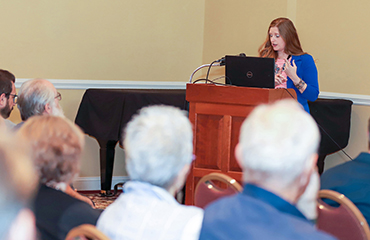
Lander University’s community lecture series continued at the Greenwood Arts Center on Tuesday, Oct. 11, with Assistant Professor of English Dr. Rachel Scoggins’s presentation, “Why We Create Monsters.”
Scoggins, who earned a Ph.D. in Early Medieval Literature and Old English at Georgia State University, said that monsters have appeared in art and literature throughout history, because they “reveal what we are scared of as a culture, and what anxieties we have.”
For instance, she said, the reptilian monster Godzilla, which terrorizes Tokyo, is an embodiment of the fears felt by the Japanese in the aftermath of World War II, following the dropping of atomic bombs on Nagasaki and Hiroshima.
In earlier times, she said, people were afraid of the unknown, and this was reflected in a fear of venturing far from home. Doing so might result in an encounter with the Donestre, a medieval “travel monster” with the head of a lion and the body of a man. The Donestre would “befriend all of the travellers that it came across. Then, however, it would devour the travellers, only leaving the decapitated head.”
Scoggins described ancient Greece as “a patriarchal and highly misogynistic society.” She said that this is reflected in female monsters like Medusa, who “with a mere look, can turn men to stone,” and in the Sirens, who “lure men to death with their sweet words and songs.”
Many works of art have expressed the fear that scientific breakthroughs can backfire.
“In ‘Jurassic Park,’ we see the dangers of playing with creation and evolution. Dinosaurs cannot be controlled, and so they turn into man-eating monsters.”
Dr. Frankenstein, likewise, “collects body parts from different people, puts them together, and uses electricity to bring the monster to life” -- with tragic results. The idea of the work, she said, is that “some things should not be messed with.”
Throughout history, she said, people have turned their enemies into monsters. For example, the crusaders saw the Muslim defenders of the Holy Land as “without humanity.” Jews in the Middle Ages were depicted as “cannibals who ate Christian children.” Columbus described the indigenous people he met in the Caribbean as “savages, animals, even devils and demons.”
According to Scoggins, “exploring monsters is a really rich and fascinating subject. If you analyze a monster, you learn a lot about the culture and the historical time in which it was created.”